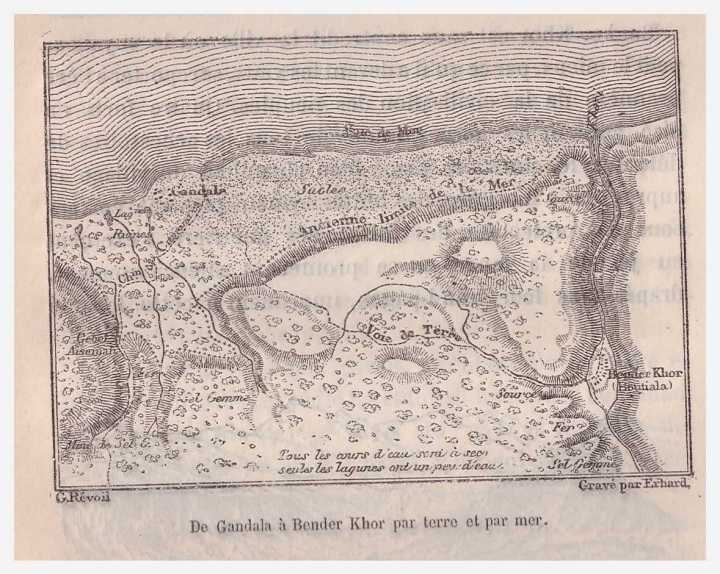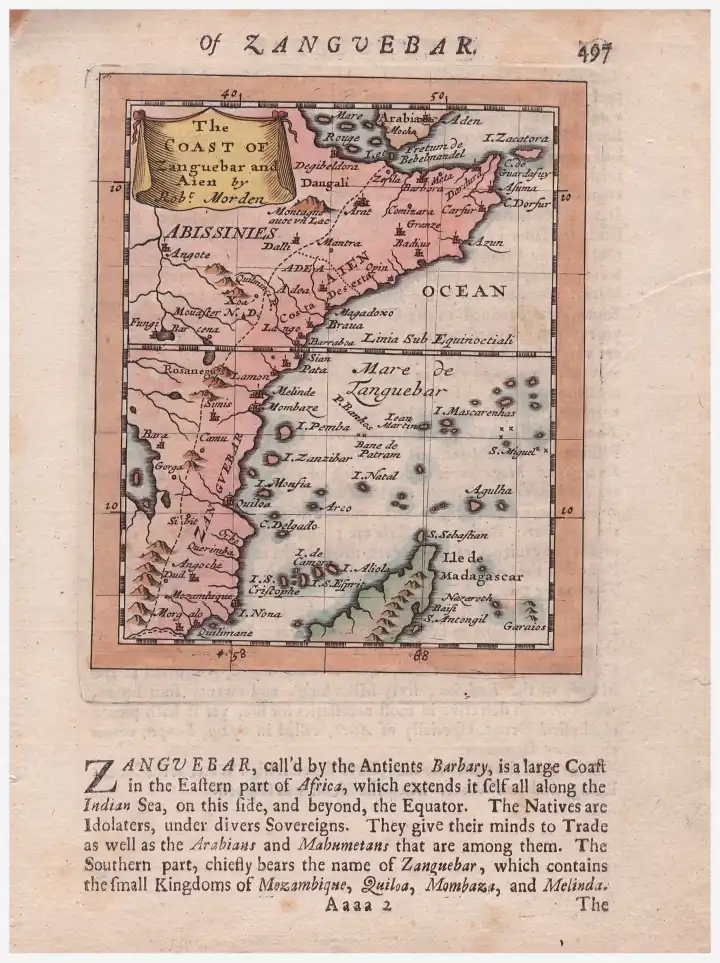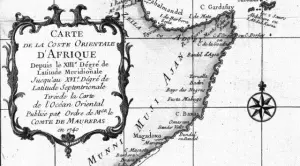1750 French map of the north east of Africa
Many of the features on this map seem largely imaginary. Some of the names on the Somalia coast are of trading ports known in antiquity but no long in existence in 1750 e.g. Opone, Mosylon, Avalites and Maleos
Qandala and Botiala
I visited Qandala in late 1991, travelling overnight by boat along the coast from Bossaso. A memorable trip!
G. Revoil described his travels along this coast 100 years beforehand in Voyage au pays des Medjourtaines (Cap Gardufui – Afrique Orientale), pages 254-269, Bulletin de la Societe de Geographie, Mars 1880.
 Here is a drawing of the town as seen from the sea. One of the two taller (mud-brick?) buildings could still be seen in 1991
Here is a drawing of the town as seen from the sea. One of the two taller (mud-brick?) buildings could still be seen in 1991
Here is a photograph taken by @XaajiBaaruud that shows one of the two-storey buildings, somewhat closer to the coast. Does anyone know anything about this building? Who built it and when?

The map below shows Qandala in relation to Bender Khor, also labeled Boutiala. Boutiala/Botiala is a site of some antiquity, as described in this Wikipedia entry
 With the help of Google Translate, I have translated Revoil’s description of Bender Khor [its a very rough translation]
With the help of Google Translate, I have translated Revoil’s description of Bender Khor [its a very rough translation]
Two different times I visit Khor Bender or Bottiala . This city is about six miles from the coast , on an island formed by the two arms of dried up Khori , a stream which pours into the sea through narrow and steep gorges. The sea arrives into these gorges, washes to the first huts of the city, maintaining a depth around 5 to 6 cubits or doudouns, which allows small sambucos or dhows to come loaded with mechandises to Bender Khor .
Bender Khor is unquestionably the city where the traveller may be the best at what he has before his eyes , refer to the first era of civilization of the people. Four adobe forts guard the gorge, complete with all defence accessories. The cemetery is placed right in the middle of the village and from the mosque, the huts scattered symmetrically under the protection of the forts: …… , contributed to this locality trapped in a huge amphitheatre and a great character that strikes the attention.
Here is his drawing of the town of Bender Khor
 There is very little left of this town at present, as can be seen in the Google Maps photo below (Lat 11° 28.538′, Lon 49° 56.947′)
There is very little left of this town at present, as can be seen in the Google Maps photo below (Lat 11° 28.538′, Lon 49° 56.947′)
The location of the four forts mentioned by Revoil is not clear. On the Revoil map shown above one high point is marked with a C, and this corresponds roughly with the ruins shown in the Google Maps photo shown below. They stand on the edge of a small plateau, about 200 metres to the west of Bender Khor, at Lat 11° 28.538′, Lon 49° 56.947′ The structure is perhaps 25 x 30 metres in size. The irregular extension to the top right of the structure may be a more recent addition, perhaps an animal enclosure.
Here is a similar structure within the Botiala settlement area, with similar small (defensive?) protrusions from the main encircling wall

This Google elevated view provides another perspective
Further towards the coast there are remains of other buildings, which may have been Revoil’s four forts.
They are between 10 and 20 metres square in size
The Wikipedia entry also says “To the north of the fortress complex is an impressive field of approximately 200 stone cairns (taalo) of varying sizes, some of which are associated with standing stones. Close by and along the shoreline are extensive shell middens. Neither structures have yet been excavated or dated“
This Google photo may show the cairns. I thought at first they were wells, but no longer think so. They are to the immediate south-west of the “four forts”
And here is a view of the same coastal valley, taken from the coast looking inland (found via Panoramio).
The gorge referred to by Revoil looks more impressive from this angle. The remains of the “four forts” may be visible on the right, above the first modest sized dark cliff overlooking the waterway
Somali coast, circa 1688
Title: Coast of Zanguebar and Aien
Creator: Morden, Robert
Place of Publication: England
Date: 1688
Published in Modern’s Atlas Terestris.
More information: http://imagesearchnew.library.illinois.edu/cdm/singleitem/collection/africanmaps/id/1066/rec/9
Described as “Rare early English map of the East African Coastline, perhaps the earliest obtainable English map of the region” The above version seems to have been colored after removal from the atlas
Mogadishu, circa 1740
Magadoxo (Mogadishu) is visible on the southern end of the east African coastline
The map was published in Antoine-François Prevosts monumentus 20 volume edition of L`Histoire Generale des Voyages published by Pierre de Hondt, The Hague in 1747.
The mapmaker: Jacques Nicholas Bellin 1703-72
Bellin spent over fifty years at the French Hydrographic Service where he was appointed the first `Ingenieur hydrographe de la Marine . During his term of office there he was commissioned to carry out major surveys, first of the coast of France and later of all the known coasts of the world. These tremendous undertakings resulted in the production of a very large number of sea charts of the highest quality, which appeared in many editions with varying numbers of charts to the end of the century. He was appointed Hydrographer to the King and was a member of the Royal society in London.











leave a comment